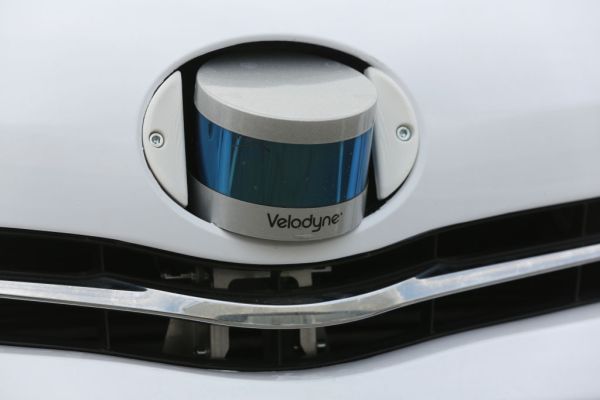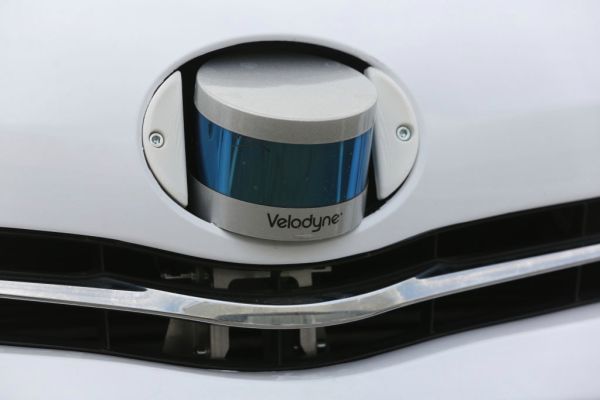
Velodyne Lidar, the leading supplier of a sensor widely considered critical to the commercial deployment of autonomous vehicles, said Thursday it has struck a deal to merge with special-purpose acquisition company Graf Industrial Corp., with a market value of $1.8 billion.
The company said it able to raise $150 million in private investment in public equity, or PIPE, from new institutional investors as well as existing shareholders of Graf Industrial. Through the transaction, Velodyne will have about $192 million in cash on its balance sheet.
Velodyne’s founder David Hall along with backers Ford, Chinese search engine Baidu, Hyundai Mobis and Nikon Corp. will keep an 80% stake in the combined company. Hall will become executive chairman and Anand Gopalan will keep his CEO position.
The merger is expected to close in the third quarter of 2020. The combined company will remain on the NYSE and trade under a new ticker symbol VLDR following the close of the business combination, Velodyne said.
The agreement marks the latest company to turn to SPACs in lieu of a traditional IPO process. Earlier this week, online used car marketplace startup Shift Technologies announced an agreement to merge with SPAC Insurance Acquisition Corp. The newly combined company will be listed on NASDAQ under a new ticker symbol. Nikola Motor also went public via a SPAC earlier this year.
Velodyne will become a publicly traded company amid a period of consolidation in the broader autonomous vehicle industry. Startups, automakers and tech giants have extended their timelines in the capitally intensive pursuit of developing and deploying AVs. Some startups have been swallowed up by larger companies, while others have become defunct. It has also prompted automakers in the past 18 months to shift more resources and attention towards advanced driver assistance systems in passenger cars, trucks and SUVs.
Lidar is perhaps one of the most crowded sub categories in the autonomous vehicle industry. Lidar is a sensor that measures distance using laser light to generate highly accurate 3D maps of the world around the car. The sensor is considered by most in the self-driving car industry a key piece of technology required to safely deploy robotaxis and other autonomous vehicles.
Velodyne is best known for its “KFC bucket” spinning-laser lidar. The design was inspired by sensor failures in vehicles competing in the DARPA Grand Challenge in 2004. Hall developed the spinning laser lidar and sold the sensors to teams competing in a future autonomous vehicle DARPA competition. The KFC buckets were the go-to lidar sensors for companies working on autonomous vehicles. Waymo, back when it was just the Google self-driving project, even used Velodyne LiDAR sensors until 2012.
However, Spinning lidar units are expensive and mechanically complex. It spurred a new generation of lidar startups to try new approaches. Today, there are dozens of lidar companies — some counts track upwards of 70 — trying to convince automakers and AV developers to use their sensors. And they’re all aiming for Velodyne.
This new generation of companies has prompted Velodyne to evolve as well. The company announced at CES 2020 in January new sensors, including a tiny $100 lidar unit called Velabit as well the VelaDome and a software product called Vella.
“There’s no argument about the market opportunity for lidar,” Gopalan told TechCrunch reporter Devin Coldewey back in January. “I think the right conversation is about what you want to do with it. Others are focused on level 2+ or 3 [autonomy, i.e. above simple driver assistance] — what we want to do is short-circuit that approach. The only reason it’s not being adopted at lower levels is price. If I say you can have lidar for a hundred dollars, of course you’re going to use it. Under a hundred dollars, you can’t even imagine the applications you open up: drones, home robotics, sidewalk robots.”
The company has spent the past several years focused on reducing the cost of its lidar as well as diversifying its portfolio. The Velabit is just one example of the company’s efforts to lock in customers outside of the AV industry. The small sensor doesn’t have the capabilities needed for autonomous vehicles. Instead, Velodyne sees an application for the sensor to be used on smaller industrial robots.
[ad_2]
Source link


